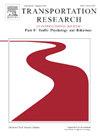重新定义积极的驾驶员行为:多维积极驾驶员行为问卷(M - PDBQ)的开发,并检查其与驾驶和安全结果的关系
IF 3.5
2区 工程技术
Q1 PSYCHOLOGY, APPLIED
Transportation Research Part F-Traffic Psychology and Behaviour
Pub Date : 2025-04-28
DOI:10.1016/j.trf.2025.04.014
引用次数: 0
摘要
与危险驾驶行为的研究相比,积极驾驶行为的研究相对较少。虽然以前的文献通常将积极的驾驶行为狭隘地定义为礼貌和亲社会行为,但这项研究主张更广泛的范围,包括安全和环保倾向。为了探索这一扩大的范围及其与驾驶和安全的联系,采用了定性和定量方法。研究1旨在探讨积极驾驶行为的多维性。为了实现这一目标,我们进行了16次半结构化访谈,以开发多维积极驾驶员行为问卷(M - PDBQ)。在随后的研究中,对628名驾驶员进行了M - PDBQ的心理测量特性及其与驾驶相关变量(如危险驾驶行为和攻击性驾驶)和道路安全结果(如交通罚单、事故)的关系进行了研究。探索性因素分析确定了三个关键维度:顺畅和主动的出行、环境可持续的行为和风险沟通,强调了积极驾驶行为的多维性。层次回归分析表明,积极的驾驶行为有可能通过减少违规和愤怒表达等危险和攻击性驾驶行为来提高道路安全。本研究通过提供一个全面的概念,开发一个新的问卷来衡量积极驾驶行为,并调查其与驾驶和道路安全的关系,促进了对积极驾驶行为的理解。本文章由计算机程序翻译,如有差异,请以英文原文为准。
Redefining positive driver behaviors: Development of the Multidimensional Positive Driver Behavior Questionnaire (M − PDBQ) and examining it in relation to driving and safety outcomes
Research on positive driver behaviors has been relatively scarce compared to studies on risky driving behaviors. While previous literature has often narrowly defined positive driver behaviors as politeness and prosocial behaviors, this study argues for a broader scope, including safety and eco-friendly tendencies. To explore this expanded scope and its connection to driving and safety, both qualitative and quantitative methods were employed. Study 1 aimed to investigate the multidimensional nature of positive driver behaviors. To achieve this, sixteen semi-structured interviews were conducted to develop the Multidimensional Positive Driver Behavior Questionnaire (M − PDBQ). In the subsequent study, the psychometric properties of the M − PDBQ and its relationship with driving-related variables (e.g., risky driver behaviors and aggressive driving), and road safety outcomes (e.g., traffic tickets, accidents) were examined with 628 drivers. Exploratory Factor Analysis identified three key dimensions: smooth and proactive mobility, environmentally sustainable behaviors, and risk communication, highlighting the multidimensional nature of positive driver behaviors. Hierarchical regression analyses suggested that positive driver behaviors have the potential to enhance road safety by mitigating risky and aggressive driving behaviors such as violations and anger expression. This research advances the understanding of positive driver behaviors by providing a comprehensive conceptualization, developing a new questionnaire to measure it, and investigating its relationship with driving and road safety.
求助全文
通过发布文献求助,成功后即可免费获取论文全文。
去求助
来源期刊
CiteScore
7.60
自引率
14.60%
发文量
239
审稿时长
71 days
期刊介绍:
Transportation Research Part F: Traffic Psychology and Behaviour focuses on the behavioural and psychological aspects of traffic and transport. The aim of the journal is to enhance theory development, improve the quality of empirical studies and to stimulate the application of research findings in practice. TRF provides a focus and a means of communication for the considerable amount of research activities that are now being carried out in this field. The journal provides a forum for transportation researchers, psychologists, ergonomists, engineers and policy-makers with an interest in traffic and transport psychology.

 求助内容:
求助内容: 应助结果提醒方式:
应助结果提醒方式:


